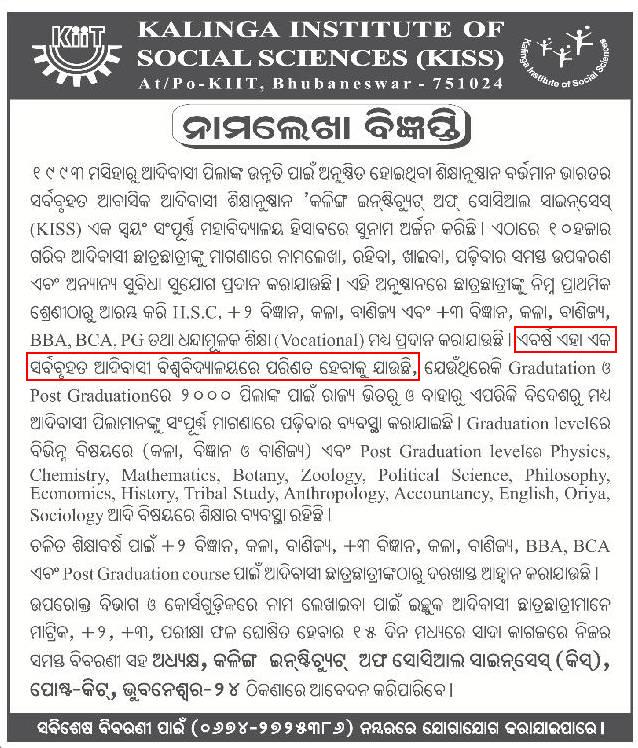The web page of Orissa Model Tribal Education Society (OMTES) is http://www.omtes.org. Following are excerpts from its "Background" page.
The Orissa Model Tribal Education Society (OMTES), a registered Society supported by the ST & SC Development Department, aims to make positive interventions in the field of tribal education. Since its inception in March 2000, it has been instrumental in setting up 11 Ekalabya Model Residential Schools in different parts of the State with assistance from Government of India. Besides that it also manages 19 Educational Complexes set up for providing education to ST Girls belonging to Primitive Tribal Groups. OMTES continues in its endeavour to serve the tribal population of the State by ensuring them to avail best opportunities in education at par with the non tribal population.
Following are some Q & A from its FAQ page.
How the schools are managed at the district level?
A school level management committee headed by the Collector of the respective districts, members including two educationist of the area looks after the overall development of the schools. Here the collector is the chairman and concerned Principal of ERMS is the Member Secretary.
I am a Tribal, what is the benefit the society has for me?
You benefit, when your child qualifies entrance of the school and receives free qualitative education. The society provides for improving the quality of tribal by promoting educational schemes for tribal community and improves the quality of life of tribal by Ashram Schools, Hostels for Tribal Boys Educational complexes, Post- Matric Scholarships and Book Bank Schemes, etc.
Whom do I contact for more information?
For information you are requested to contact ST & SC Development, Govt. of Orissa.
The 11 schools are listed in the page http://www.omtes.org/Yearwise_establishment_EMRS.html. They are in the districts of Koraput, Mayurbhanj, Sundergarh (3), Rayagada, Koenjhar, Gajapati, Kandhamal, Nabarangpur, and Jajpur.
The 19 educational complexes are listed in the page http://www.omtes.org/Yearwise_establishment.html. They are in the districts of Keonjhar (3), Rayagada (2), Nuapara, Mayurbhanj (2), Deogarh, Angul, Kalahandi, Ganjam, Gajapati (3), Malkangiri (2), Sundergarh and Kandhamala. Each of these complexes have a capacity of 250 making a total capacity of 4750.
In contrast, as of today, KISS has a student body of 15,083, which includes 3553 students pursuing +3. KISS had a student body of 1500 in 2005. I am sure the performance of the students is better at KISS than of the students at the OMTES schools and educational complexes.
So the Odisha government should just give land, seed money and grants to KISS and let them establish and manage much larger facilities in the districts with significant tribal students.
In http://www.kiss.ac.in/admission.html it is mentioned that every year KISS gets 30,000 to 40,000 applications per year for admission and admits between 2000-3000 of them. The government should fund KISS so that if not all who apply are admitted at least half of them are admitted.
It is a pity that other states have taken note of KISS and are inviting KISS to open replicas in their states while Odisha does not seem to be taking similar steps. Following is an excerpt from a report in Pioneer on other states approaching KISS for replicas.
A branch of the Kalinga Institute of Social Sciences (KISS) has been set up in Bastar, a tribal dominated and Maoist infested region of Chhattisgarh with assistance from the National Mineral Development Corporation (NMDC).
An MoU to this effect was signed between the KIIT and the KISS founder Dr Achyuta Samanta and NMDC director GB Joshi in the presence of the NMDC chairman cum managing director Rana Som at the the latter’s Corporate Office in Hyderabad on June 24.
As per the agreement, the NMDC has provided 30 acres of land along with all financial assistance to the KISS in order to set up its replica in Kankar region of north Bastar district in Chhattisgarh. In the first phase, 1000 tribal boys and girls will be admitted in this school. However, a total of 4,000 students from five districts in and around Bastar will get the opportunity of quality education here in course of time.
After Bastar, the Governments of Jharkhand, Madhya Pradesh and Delhi are keen to set up such model schools bearing all financial implications. They have requested Dr Samanta accordingly.
The page http://www.kiss.ac.in/fmngt.html explains how KISS is funded. The total amount there adds up to 18 crores. If 10 such KISS replicas are established in 10 tribal districts of Odisha at an additional cost of 200 crores/year, that will be the best use of such money for Odisha.
July 8th, 2011
Following are excerpts from http://chronicle.com/article/In-India-a-Top-Private/125169/.
The Kalinga Institute of Social Sciences, known as KISS, has 10,000 students, and offers a full range of educational services, including primary and secondary school, vocational education, and undergraduate and graduate courses. It’s what Mr. Samanta and his staff like to call "a KG to PG" institution, that is, kindergarten to postgraduate. (In India, graduate programs are referred to as postgraduate programs.)
For the past nine years, all his tribal students entering grade 12—many of whom had probably never seen a chalkboard before they enrolled in KISS—have graduated. By comparison, Indian public high schools graduate only 60 to 70 percent of their senior classes, on average.
KISS’s vocational, undergraduate, and graduate programs complement one another, Mr. Samanta says, because the vocational courses teach students how to "earn while they learn." While they study in college, he says, they can continue to send a third of their earnings—about $15 to $20—to their parents. For people who may be living on as little as a dollar a day, it’s a significant amount.
KIIT University and the social-sciences institute are housed on a vast campus that is on par with the best Indian universities, with air-conditioned buildings, wireless Internet, multimedia classrooms, laboratories, and conference halls. The campus feels like an ashram with walkways connecting airy buildings and small ponds scattered throughout the grounds.
October 29th, 2010
Our sister site in Twitter is http://twitter.com/orissalinks. (Often when we are busy or do not feel like writing a full posting here, we post a micro-blog in our Twitter sister site. The Twitter sister site also automatically adds the headline from this site and the orissagrowth site. Once in a while we will collect those headlines here. But readers wanting a broader and more immediate coverage should consider following our Twitter site at http://twitter.com/orissalinks.) Following are some selected items from that site since July 12th.
August 20th, 2009
As per its web page, currently the KIIT group has the following institutions:
In 2009 it is starting four new schools:
- Mass communication
- Design
- Film studies
- Sculpture
In addition KISS (Kalinga Institute of Social Sciences) plans to offer Mastesr program in Physics, Chemistry, Mathematics, Botany, Zoology, Political Science, Philosophy, Economics, History, Tribal study, Anthropology, Accountancy, English, Oriya, and Sociology. the following ad for admission to KISS suggests that it will soon be a university on its own.

Considering the way KIIT is going one day the group may have the maximum number and variety of programs among all universities in India. Below are a list of programs at the Bachelors/Masters level that come to mind that the KIIT group does not yet have. Readers are requested to suggest additional programs.
- School of Architecture
- School of Physical and Earth Sciences (Mathematics, Statistics, Physics, Chemistry, Geology, Earth Science)
- School of Life Sciences (Biology)
- Schoolof Liberal Arts (Economics, Political science, Geography, Philosophy, Sociology, Anthropology, History, Linguistics, Psychology, Sociology, Women and Gender studies)
- School of Public Health
- School of Archaeology
- School of performance arts (Music, Dance, Theater, various instruments, various kinds of vocals) – with regular events for locals
- School of Fine Arts and Creative Writing (Art education, Art history, Art studies, ceramics, drawing, fibres, metals, painting, photography, print making)
- School of Business (Accountancy, Finance, Entrepreneurship, Marketing)
- Additional Engineering fields: Industrial engineering, Chemical engineering, Bioengineering, Petroleum Engineering, Mining Engineering, Metallurgical Engineering, Biomedical Engineering, Environmental Engineering, Aerospace Engineering
- Culinary Institute
- School of Public Policy and Government
- School of Energy and Sustainability
- School of Construction
- School of Medical technology (including Bio-Medical Informatics)
- School of Nursing
- Programs in Social Service
- School of Agriculture
- School of Veterinary Science
- School of Education (including special education)
- School of Agri-business, Food science and Nutrition
- School of Tourism
- School of Sports sciences and Kinesiology
- School of Religious studies
- School of Aviation and Aviation management
June 7th, 2009
The following is from http://www.ugc.ac.in/notices/pendingprosaldawis160409.pdf.
| Name |
Date proposal received |
Status |
Krupajal Engineering College,
Pubasasan, Kausalya Ganga,
Bhubaneshwar – 2,
Orissa.
De-novo |
F. 9-17/2007-
U.3 (A) dated
15.3. 2007
withdrawn.
Fresh proposal
received under
De-Novo
No. F.9-27/2008
dt. 15.4.08 |
Expert Committee
constituted.
UGC No. 35-1/2007
(CPP-I). |
College of Engineering
Bhubaneswar, Under
Nabadigant Educational Trust,Plot No. 1, Sector – 3,
Chandaka Nucleus Industrial
Complex, Patia, Bhubaneswar
– 751 024, Orissa.
De-novo |
F.9-30/2007-U.3
(A) dated 15th
May, 2007 |
The Institute has been
asked to comply with the
deficiencies vide UGC Letter No. F. 35-3/2007
(CPP-I) dated 27th
August, 2007 |
Asian School of Business
Management Bhubaneswar,
Orissa.
De-novo |
F.9-45/2007-U.3
(A) dated 18th
September,
2007 |
The Institute has
complied with the
deficiencies are under
consideration.
UGC Letter No. F. 35-
5/2007 (CPP-I) |
Vidya Bharti University,
Gunupur
Distt. Rayagada, Orissa |
F.9-60/2007-
U.3(A) dated
28.11.2007 |
Letter to the State
Government has issued
for NOC.
UGC NO. F.35-6/2007
(CPP-I) dt. 25.3.2009. |
Koustav Institute of Self
Domain
Patia, Bhubaneswar,
Orissa.
De-novo |
F. 9-68/2007-
U.3(A) dated 9th
January, 2008 |
Information has been
called in checklist
proforma vide UGC Letter
F. 35-1/2008 (CPP-I) dt.
4.2.2008. |
HI-TECH University
Plot No. A-170, Saheed
Nagar,
Bhubaneswar, Orissa. |
F. 9-4/2008-
U.3(A)
dated 15th
January, 2008 |
Information has been
called in checklist
proforma vide UGC Letter
F. 35-2/2008 (CPP-I) dt.
6.2.2008. |
C.V. Raman University
Bhubaneswar,
Orissa. |
F. 9-67/2007-
U.3(A) dated 9th
January, 2008 |
The Institute has been
asked to comply with the
deficiencies vide UGC
letter No. F. 35-4/2008
(CPP-I) dt. 12.3.09 |
Orissa Institute of Technology
P.O.-Burla,
Distt-Sambalpur – 758018
Orissa |
F. 9-41/2008-
U.3(A) dated 9th
July, 2008 |
The Institute has been
asked to comply with the
deficiencies vide UGC
letter No.F.35-5/2008
(CPP-I) dt. 2.3.2009. |
Kalinga Institute of Social
Sciences,
Ai/PO-KIIT,
Bhubaneswar-751024
De novo |
No.F.9-1/2008-
U3(A) dated 27th
January, 2009 |
The Institute has been
asked to comply with the
deficiencies vide UGC
letter No.F.35-1/2009
(CPP-I) dt.25.3.2009
|
Among the above, Orissa Institute of Technology, has already been declared a state university with the new name VSSUT.
May 9th, 2009

